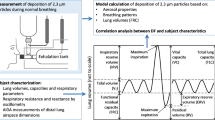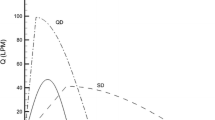Abstract
Analytical estimates of the respirable fractions on inhaled pharmaceutical aerosols are obtained by inertial sampling techniques. The respirable fraction may be defined as that portion of the particle size distribution less than a designated diameter. The diameter size below which particles were considered respirable in these studies was 6.4 µm. In clinical practice, a variety of particle size distributions may be related to a single respirable fraction. Herein, three respirable fractions were each defined by six particle size distributions. The deposition patterns of aerosols exhibiting these particle size characteristics were examined in a mathematical model. The analytically defined respirable fractions were compared with predicted lung deposition values. Under clearly defined breathing conditions, there is a correlation between the nominal respirable fraction and deposition. However, it was concluded that the variations which occur in breathing parameters within patient populations may not allow a single analytically derived respirable fraction to be appropriate for all individual subjects.
Similar content being viewed by others
REFERENCES
British Pharmacopoeia, Vol. II, Appendix XVIIB, HMSO, London, pp. A204–A207.
USP Advisory Panel on Aerosols (1985–1990). Report and Recommendations of the USP Advisory Panel on Aerosols on the USP General Chapter 〈601〉 on Aerosols. Pharm. Forum 17:1703–1713 (1991).
A. J. Hickey. Factors influencing aerosol deposition in inertial impactors and their effect on particle size characterization. Pharm. Tech. 14:118–130 (1990).
O. G. Raabe. A general method for fitting size distributions to multicomponent aerosol data using weighted least-squares. Env. Sci. Tech 12:1162–1167 (1978).
W. Stahlhofen, G. Rudolf, and A. C. James. Intercomparison of experimental regional aerosol deposition data. J. Aerosol Med. 2:285–308 (1989).
T. B. Martonen. Aerosol therapy implications of particle deposition patterns in simulated human airways. J. Aerosol Med. 4:25–40 (1991).
T. B. Martonen, R. C. Graham, and W. Hofmann. Human subject age and activity level: Factors addressed in biomathematical deposition program for extrapolation modeling. Health Phys. 57:49–59 (1989).
K. Fults and A. J. Hickey. Correlation of estimated respirable fraction of an aerosol with theoretical lung deposition. Pharm. Res. 8:S6 (1991).
E. M. Phillips, P. R. Byron, K. Fults, and A. J. Hickey. Optimized inhalation aerosols. II. Inertial testing methods for aerosol particle size analysis. Pharm. Res. 7:1228–1233 (1990).
K. Fults, T. D. Cyr, and A. J. Hickey. The influence of sampling port geometry upon particle size measurement using an inertial impactor. J. Pharm. Pharmacol. 43:726–728 (1991).
A. J. Hickey. An investigation of size deposition upon individual stages of cascade impactor. Drug Dev. Ind. Pharm. 16:1911–1929 (1990).
O. G. Raabe. Particle size analysis utilizing grouped data and the log-normal distribution. J. Aerosol Sci. 2:289–303 (1971).
T. Allen. In Particle Size Measurement, Chapman and Hall, London, 1990, pp. 156–170.
T. B. Martonen. Measurement of particle dose distribution in a model of a human larynx and tracheobronchial tree. J. Aerosol Sci. 14:11–22 (1983).
T. B. Martonen. Development of surrogate lung systems with controlled thermodynamic environments to study hygroscopic particles: Air pollutants and pharmacologic drugs. Particle Sci. Tech. 8:1–20 (1990).
T. B. Martonen and J. Lowe. In V. A. Marple and B. Y. H. Liu (eds.), Aerosols in the Mining and Industrial Work Environments, Ann Arbor Science, Ann Arbor, MI, 1983, pp. 151–164.
T. B. Martonen. On the fate of inhaled particles in the human: A comparison of experimental data with theoretical computations based on a symmetric and asymmetric lung. Bull. Math. Biol. 45:409–424 (1983).
T. B. Martonen, W. Hofmann, A. D. Eisner, and M. G. Menache. In J. D. Crapo, E. D. Smolko, F. J. Miller, J. A. Graham, and A. W. Wallace (eds.), Extrapolation of Dosimetric Relationships for Inhaled Particles and Gases, Academic Press, San Diego, 1989, pp. 303–316.
T. B. Martonen. Analytical model of hygroscopic particle behavior in human airways. Bull. Math. Biol. 44:425–442 (1982).
T. Martonen. Deposition of inhaled particulate matter in the upper respiratory tract, larynx, and bronchial airways: A mathematical description. J. Toxicol. Environ. Health 12:787–800 (1983).
E. R. Weibel. Morphometry of the Human Lung, Academic Press, New York, 1963.
J. Heyder, J. Gebhart, G. Rudolf, C. F. Schiller, and W. Stahlhofen. Deposition of particles in the human respiratory tract in the size range 0.005–15 µm. J. Aerosol Sci. 17:811–825 (1986).
A. J. Hickey and T. B. Martonen. Behavior of hygroscopic pharmaceutical aerosols and the influence of hydrophobic additives. Pharm. Res., 10(1): in press (1993).
R. W. Rance. Studies of the factors controlling hair sprays. III. The influence of particle velocity and diameter on the capture of particles by arrays of hair fibers. J. Soc. Cosmet. Chem. 25:545–561 (1974).
Author information
Authors and Affiliations
Rights and permissions
About this article
Cite this article
Martonen, T.B., Katz, I., Fults, K. et al. Use of Analytically Defined Estimates of Aerosol Respirable Fraction to Predict Lung Deposition Patterns. Pharm Res 9, 1634–1639 (1992). https://doi.org/10.1023/A:1015880828704
Issue Date:
DOI: https://doi.org/10.1023/A:1015880828704




